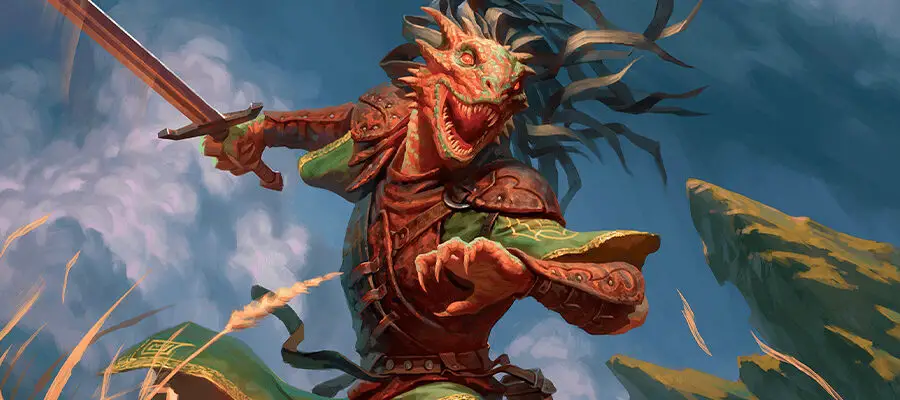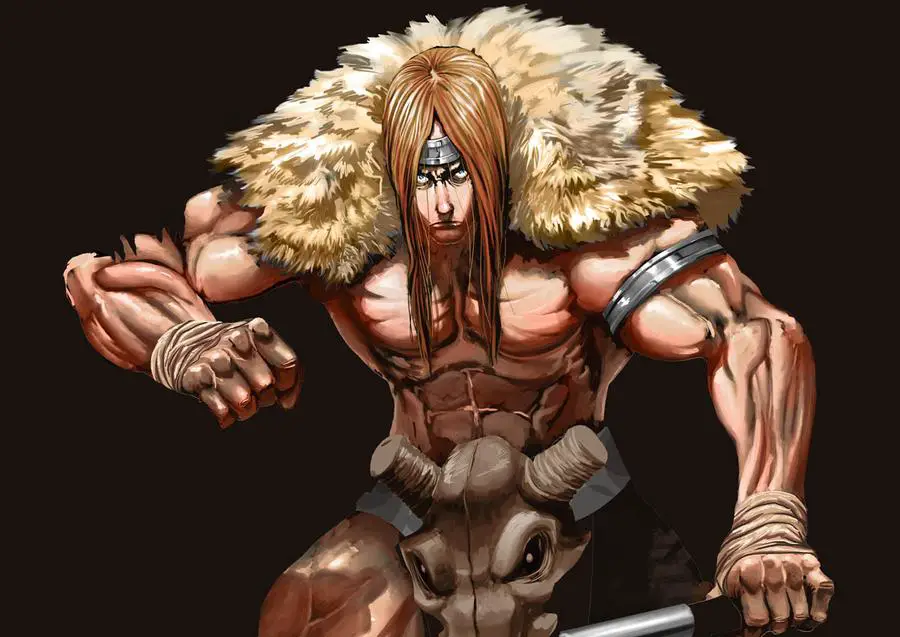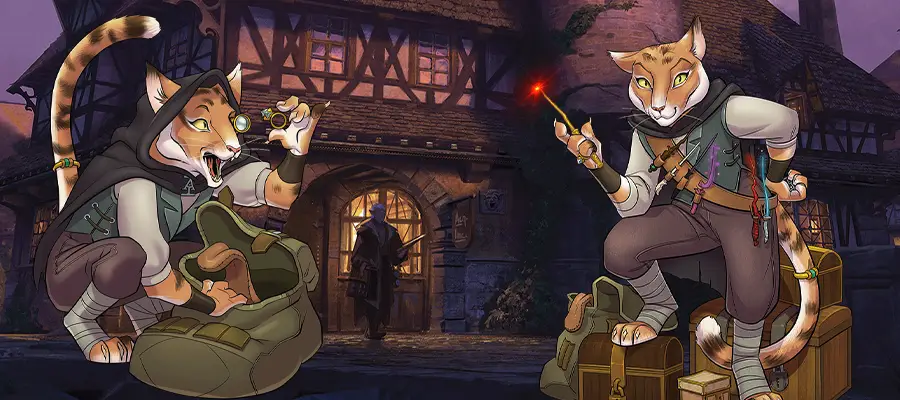This article’s featured image for D&D 5e Ranger Subclass Ratings Ranked Best to Worst is from Fizban’s Treasury of Dragons. This article contains affiliate links that add gold to our coffers.
D&D 5e Ranger subclasses have been a point of contention in the greater D&D community since D&D 5e was released. I’ve seen many players adopt the early Ranger options and feel like it didn’t match their expectations. Have those subclasses aged well? What about newer subclasses? Let’s objectively analyze each Ranger subclass to rate them and rank them.
Premise and Rating System
I’m rating each subclass based on the game overall for Rangers only, so I’m not comparing a Ranger subclass to a Wizard subclass. That wouldn’t feel fair. I also rate each subclass based on five criteria:
- Subclass Features: How the abilities and perks synergize. I look at all levels of play, not just low levels like many do these days. I play at high levels, plenty enough to look at those features.
- Game Design: How well do the features avoid misunderstandings and how well do they fit into the game overall? Features that are clunky or feel exploitative will suffer.
- Fun: If a subclass feels easy and enjoyable for the average player to pick up, it will be rated well here.
- Versatility: I like to see subclasses that can be played and flavored in multiple ways without feeling stuck.
- Lore & Roleplaying: Subclasses that evoke fantasy and live up to it will do well here.
This clearly isn’t a science, but it’s the system that works for me! It also helps me to be objective and not feel burdened by community perceptions. I’m biased to favor innovation and the freshness of mechanics or concepts.
Quick Poll: Favorite Ranger Subclasses from the 5e Community
Before or after you read through my Ranger subclass ratings, let us know which is your favorite! Voting will reveal the votes of others, too.
Skip to Your Favorite Ranger Subclass Rating
— Beast Master
— Drakewarden
— Fey Wanderer
— Gloom Stalker
— Horizon Walker
— Hunter
— Monster Slayer
— Swarmkeeper
Beast Master Ranger Subclass Rating (PHB and TCoE)
Summary of subclass features: Train a beast to be your companion and fight by your side. This subclass has been updated in TCoE to make it more viable with a choice of three spirit forms to act as your beast companion. You share your action economy with your beast companion, somewhat.
- Subclass Features: ★★★
- Game Design: ★★★
- Fun: ★★★
- Versatility: ★★★★
- Lore & Roleplaying: ★★★★
Flutes’ Evaluation (4/5)
The Beast Master is much better than it used to be in the PHB. I recommend using the version from Tasha’s Cauldron of Everything.
This subclass has received much hate since 5e was released. It was clunky and didn’t match the power fantasy of many players who wanted a Ranger with a pet. It received a new coat of paint in Tasha’s to breathe new life into it. It’s actually a good subclass, but it has always required too much from new players to be effective. The narrative incongruity of needing to choose between the Ranger or the beast attacking creates friction for players. Players don’t enjoy friction between game mechanics and logic/narrative. Tasha’s provided the alternative Primal Companion with beast spirits of land, sea, and sky to remedy player frustration with this iconic subclass. The biggest difference is allowing the Beast Master to command the Primal Companion as a bonus action instead of an action. Primal Companions also don’t have the dead pet problem.
The beast/primal companion receives magical attacks at level seven with Exceptional Training. This is important to stay relevant. Exceptional Survivability is better now, and the flavor/description of the beast is freely changed to match the player. I don’t like that the first part of Exceptional Training is irrelevant for Primal Companions (using a bonus action to use non-attacks).
Drakewarden Ranger Subclass Rating (FToD)
Bonus cantrips: Thaumaturgy
Summary of subclass features: Learn Draconic and use Thaumaturgy for elemental flavor. Get a small drake companion that develops based on your Proficiency Bonus and Ranger levels (varying from feature to feature). The drake later grows in size to eventually be large, evolves resistance opportunities, gains flight, and magic-infused elemental attacks. The flight becomes limited if you mount the drake before level fifteen. You also gain a kind of dragon’s breath for your character at higher levels. Your bonus action may often be used to command your drake. At later levels, your reaction may become busy as you share damage with your drake.
- Subclass Features: ★★★★★
- Game Design: ★★★★
- Fun: ★★★★
- Versatility: ★★★★★
- Lore & Roleplaying: ★★★★★
Flutes’ Evaluation (5/5)
The updated Beast Master from TCoE is probably stronger at low-to-mid levels, while the Drakewarden pulls ahead beyond fifteenth level. However, the Drakewarden may feel thematically stronger compared to a dull beast (depending on player style).
The drake is fantastic! The game design around the drake is smart, fun, and calculated. Designers controlled the flight and mount abilities in a purposeful way. I wish the flight wasn’t completely restricted while mounted at level seven since plenty of classes of limited flight at the same level. I would’ve liked to see a limited ten-foot flying speed until later levels. Growing the drake’s size reflects the subclass’ good design; the design gets better with the level-seven feature allowing a medium-size player character to mount the medium-size drake (normally not possible by the rules).
A loophole can allow the Ranger to fly with the drake at level seven despite the mount limitation. There’s nothing in Bond of Fang and Scale that says the drake can’t grapple you and pull you into the air. As long as the drake and the Ranger are appropriate sizes for the drake to grapple the Ranger, slow flight is possible. Ask your DM if they’d allow your drake to grapple you with one of its legs or with its mouth like a lion cub!
The breath weapon at level eleven is fun since Ranger or drake can exhale the effect. Your bonus action remains open to command the drake to attack. I appreciate how it scales with an additional 2d6 at level fifteen. Additional subclass scaling for flight, damage, and defense at level fifteen is appreciated. I would’ve been sad if the drake didn’t become formidable in a campaign, but it feels like a true companion keeping pace with the Ranger.
This is not the strongest Ranger subclass, but it’s impressive to me. I wish more subclasses could be this well put together. The suggestions for the backstory/origin of the Drakewarden’s powers are cool, too. If the drake had a reliable ranged attack, this subclass would be even better.
Lastly, I’m not sure why the drake attacks do not become magical. The Beast Master’s companion gains magical attacks, but an actual dragon spirit does not. They deal elemental damage bonuses, but the attack itself isn’t magical. This can be severely limiting beyond tier-one play. Maybe your DM would rule to treat the entire attack as magical.
Fey Wanderer Ranger Subclass Rating (TCoE)
Bonus proficiencies: Choice of Deception, Performance, or Persuasion
Bonus spells:
- Charm Person
- Misty Step
- Dispel Magic
- Dimension Door
- Mislead
Summary of subclass features: Deal more damage once per turn and add Wisdom to Charisma skill checks. Turn charms and fright effects back on their users. Summon fey creatures and teleport like crazy around the battlefield.
- Subclass Features: ★★★★★
- Game Design: ★★★★★
- Fun: ★★★★★
- Versatility: ★★★★★
- Lore & Roleplaying: ★★★★★
Flutes’ Evaluation (5/5)
Dreadful Strikes is a minor damage supplement, but it feels good. You may be tempted to think this feature only adds damage once per turn, but that’s not quite true. The damage can be dealt per creature once per turn. This means if you slay one monster and move to the next, both can suffer the psychic damage boost. You can also deal this damage on other creatures’ turns with opportunity attacks. The slight scaling is nice to have.
The spell list is fantastic and thematic. They’re spells that can be useful at the level gained (even though later as a half-caster class), and they can remain relevant at higher levels. Each spell is also unique to the Ranger.
Appearances and origins for this subclass are fun and easy to imagine. Players can easily grasp the fantasy behind the subclass and make it their own. These features inform the roleplaying, and the roleplaying is reinforced by the Otherworldly Glamour feature. Adding Wisdom to Charisma checks is easy and useful for a Ranger.
Beguiling Twist is iconic for this subclass. It’s such a cool concept to turn charm and fear back on enemies. You can also salvage your own failed spell to try charming or frightening a second target. These saving throws are fairly common, too.
Fey Reinforcements is a fantastic use for the Summon Fey spell. The option to remove concentration is also stellar. I love these game design choices. The Fey Spirit’s abilities are useful for creative players. The Mirthful bonus action synergizes with the Fey Wanderer’s Beguiling Twist feature.
Misty Wanderer gives a supply of Misty Step castings that won’t drain your spell slots. You can also bring an ally with you when you teleport with Misty Step, a feature usually reserved for Dimension Door. I love it!
This subclass is one of the best designs in the game. I mean that. There isn’t a feature of this subclass that creates friction with mechanics or thematics. I’d gladly play the Fey Wanderer Ranger. It’s not the most powerful Ranger conclave by damage output, but I don’t mind dealing less damage here.
Gloom Stalker Ranger Subclass Rating (XGtE)
Bonus spells:
- Disguise Self
- Rope Trick
- Fear
- Greater Invisibility
- Seeming
Summary of subclass features: Bonus to Initiative, additional attacks with speed and damage boosts, darkvision, and invisibility in the dark to creatures relying on darkvision. Wisdom saving throw proficiency, additional attacks after missing, and imposing disadvantage on enemy attacks.
- Subclass Features: ★★★★★
- Game Design: ★★★★★
- Fun: ★★★★★
- Versatility: ★★★★
- Lore & Roleplaying: ★★★★
Flutes’ Evaluation (5/5)
Most Ranger enthusiasts and casuals will think this is the top Ranger subclass. I’m not convinced it is. I certainly think it has amazing damage output with features that appeal to the most common combat needs: Initiative boosts, Wisdom saving throws, and additional attacks/damage. It’s certainly a strong subclass, but it doesn’t have the high-level appeal that some of the other Ranger subclasses have. It also doesn’t inspire me with its theme.
Being unseen to darkvision is nuts. Ambushing enemies for nova damage with an additional attack and 1d8 is fantastic. The spell list is ok, but at least the spells are unique to Rangers.
Iron Mind isn’t exciting, but passively gaining Wisdom saving throw proficiency is never bad (in fact, it’s really good). Stalker’s Fury at level eleven is when the subclass slows down. Shadowy Dodge is lackluster at level fifteen. Fortunately, this subclass is front-loaded enough to not worry about the high-level duds. It’s common for Rangers to multiclass at level ten after getting the new Tasha’s feature, Nature’s Veil (fantastic invisibility option). This subclass is insanely powerful, and Tasha’s made it even better.
Again, this subclass is very strong. It is showcased on many top-tier character builds. However, that doesn’t mean I consider it the top Ranger subclass.
Horizon Walker Ranger Subclass Rating (XGtE)
Bonus spells:
- Protection from Evil and Good
- Misty Step
- Haste
- Banishment
- Teleportation Circle
Summary of subclass features: Detect nearby portals, add force damage to your attacks as a bonus action, and become ethereal. Teleport between attacks and gain an additional attack, and use your reaction to resist damage from an attack.
- Subclass Features: ★
- Game Design: ★★
- Fun: ★★★
- Versatility: ★★★
- Lore & Roleplaying: ★★★
Flutes’ Evaluation (2/5)
The Horizon Walker has cool features that I would’ve liked to see somewhere else. I see the unrealized potential, but there are traps in this subclass that will trip up players.
Spells are tricky for Rangers since they don’t typically invest in Wisdom without incentive. Most of the bonus spells of the Horizon Walker are fine additions to the character. Many Rangers will likely multiclass at higher levels.
Sensing portals with Detect Portal is so niche it’s practically a non-feature. Beg your DM to make this worth having.
Planar Warrior requiring a bonus action is too steep of a tax for the effect it gives. Newer subclasses clearly improved on this failure.
Ethereal Step is so close to greatness, but wow, it really lets me down. This special casting of Etherealness only lasts for the current turn, so you need to have a very specific task in mind.
Distant Strike is the coolest feature of the subclass. I would’ve liked it at level seven, so I recommend swapping it with Ethereal Step. It takes a lot of homebrew to fix this subclass. I love the idea of teleporting between attacks, but in practice, it’s tough to justify spreading attacks instead of focus-firing.
Spectral Defense is a common defensive reaction that I see in 5e, but this one comes late without additional perks. Time to multiclass!
Hunter Ranger Subclass Rating (PHB)
Summary of subclass features: Choose between two or three options at different levels to specialize in combat against specific foes. You might specialize in taking down enormous enemies or hordes of smaller ones. Some options will favor ranged or melee attacks. Many of the abilities are similar to features from other classes, particularly the Rogue.
- Subclass Features: ★★★★
- Game Design: ★★★★
- Fun: ★★★★
- Versatility: ★★★★★
- Lore & Roleplaying: ★★★
Flutes’ Evaluation (4/5)
This is the OG Ranger of D&D 5e! It was once the standard for Rangers, but now it has been overshadowed. It’s not bad, but it’s a victim of power creep (rightfully so, in my opinion).
Hunter’s Prey gives three options with varying effectiveness. Colossus Slayer should be ignored. Giant Killer is useful for melee builds who want to weaponize their reactions, but it’s less useful at higher levels when gigantic enemies can attack with reach. Horde Breaker is my favorite because it potentially provides another attack when using the attack action, making it fun for a sniper to take down multiple enemies. I enjoy the versatility for different styles, though an easy upgrade would be to allow the Hunter to switch their choice when they rest (commonplace in modern 5e).
Defensive Tactics gives three more options. Escape the Horde is garbage. Multiattack Defense is only useful for enemies making many attacks. Steel Will may be the best option since many monsters utilize fear effects, though I’d be most players prefer the feel of Multiattack Defense.
Multiattack (poor naming) is at level eleven with two options. Volley is clearly superior to Whirlwind Attack. You don’t need special placement for Volley and reliably can hit many more enemies.
The final choice tree is at level fifteen with Superior Hunter’s Defense. Evasion is always solid, though the Hunter gets it much later than a Rogue. Stand Against the Tide can be fun when the Hunter is swarmed by multiple enemies. Uncanny Dodge is another Rogue ability that is great to have. This is the choice tree that seems the most difficult for me to identify the best option, but Uncanny Dodge may be best for most characters. It really depends on the campaign. Keep in mind you don’t want too many reaction options if you’ve already chosen a few.
My favorite way to play a Hunter is as a ranged attacker, so my choices would be (in order by leveling up) the following: Horde Breaker, Steel Will (potentially Multiattack Defense), Volley, and Uncanny Dodge. What would you pick?
Monster Slayer Ranger Subclass Rating (XGtE)
Bonus spells:
- Protection from Evil and Good
- Zone of Truth
- Magic Circle
- Banishment
- Hold Monster
Summary of subclass features: Sense a creature’s strengths and weaknesses. Use a bonus action to mark an enemy for bolstered damage and defenses when you combat it. Foil spells and teleportation attempts with your reaction. Marked creatures may be attacked by your as a reaction when they force you to make a saving throw, potentially allowing you to automatically succeed at the save.
- Subclass Features: ★★★
- Game Design: ★
- Fun: ★★★
- Versatility: ★★
- Lore & Roleplaying: ★★★
Flutes’ Evaluation (2/5)
Hunter’s Sense is garbage. It requires an action to activate, and it gives information that DMs often divulge anyway if you simply attack. Playing this subclass might have the meta-effect of making the DM gate information they normally wouldn’t so they don’t negate your subclass (awkward).
Slayer’s Prey is underwhelming, but at least it can be used without a resource. Costing a bonus action to gain 1d6 once per turn is sad compared to better bonus actions.
Supernatural Defense is ok, but it still requires the setup from Slayer’s Pray. If your Initiative is poor or you don’t invest your bonus action with the correct enemy, you’re sunk.
Magi-User’s Nemesis would be useful and enticing if it wasn’t limited to once per rest. An easy upgrade would be to make it usable PB times per rest. It still behooves you to have a high Wisdom score to improve your DC for this ability, which is a high tax for Rangers who don’t have other features with that incentive.
Slayer’s Counter is another useful ability for dealing with spellcasters and tricky monsters. You can attack while defending yourself. Setting up with Slayer’s Prey is still troublesome, but I like this feature well enough.
Overall, this subclass is clunky. It has cool concepts, but poor execution. I’m docking its game design score heavily. I don’t like much about this subclass. Oh, and I don’t like the spell list for this subclass.
Swarmkeeper Ranger Subclass Rating (TCoE)
Bonus cantrips: Mage Hand
Bonus spells:
- Faerie Fire
- Web
- Gaseous Form
- Arcane Eye
- Insect Plague
Summary of subclass features: Utilize a swarm of your flavor choice to amplify your attacks. You can push enemies, deal more damage, or move when you attack. Gain slow flight, defensive dispersal, and greater swarm attacks. Spells can be flavored to resemble your swarm of choice.
- Subclass Features: ★★★★★
- Game Design: ★★★★★
- Fun: ★★★★★
- Versatility: ★★★★★
- Lore & Roleplaying: ★★★★★
Flutes’ Evaluation (5/5)
The Swarmkeeper is one of WotC’s best subclass designs to encourage customization, flavoring, and reskinning. They provided two paragraphs just encouraging players to have fun with this, and they have! I also appreciate the modern D&D 5e subclasses having multiple uses of their interesting features per long rest so you can actually use them effectively.
The versatility of Gathered Swarm is superb. The forced movement option can be massive at times. The damage boost is a nice default. The self-movement is also great if you need to Disengage from an adjacent enemy. Each option sings with the swarm theme. Mighty Swarm at level eleven gives useful upgrades to the base features. Team up with allies who can capitalize on forced movement and the prone condition. You’ll be popular.
Mage Hand is a smart touch (no pun intended) to the subclass. The swarm helps you move things around like a telekinetic power. The other spells gained are fantastic for the theme and they’re strong spells. Insect Plague isn’t great, especially at level seventeen, but it’s obviously going to be on this spell list.
Writhing Tide’s concentration-free flight (slow as it may be) is always welcome. The flight includes hover, so you won’t fall if knocked prone or something. Your maneuverability and survivability also improve at level fifteen; you’ll be reacting to damage by resisting it and teleporting (double whammy)!
This is one of the only subclasses I’d prefer to play over the Gloom Stalker. Old GS is certainly powerful, but I prefer these other subclasses that I’m ranking higher. The Swarmkeeper is too fun to settle for merely dealing damage and skulking about.
I wrote an article about how this subclass can be used to play as Gaara the sand ninja from Naruto. If you’re into that, check it out!
Ranger Subclass Rankings Best to Worst
- Swarmkeeper
- Fey Wanderer
- Gloom Stalker
- Drakewarden
- Hunter
- Beast Master
- Horizon Walker
- Monster Slayer
My top two picks received full marks. They’re fantastic! If I were to play in a smaller party with fewer opportunities for team combos, I’d go Fey Wanderer. In a larger party forced-movement shenanigans, I’d go Swarmkeeper. Having said that, I believe these subclasses are both team players that can function autonomously.
You may scoff that Gloom Stalker isn’t at the top, but I’m not discounting the subclass’ power. It’s not the most interesting (important to my grading system), and that’s all there is to it for me. The invisibility/unseen features of the Gloom Stalker are the most interesting to me; I love those. Gloomstalker features heavily in power builds for a reason, but that doesn’t mean I’m excited to play it.
Xanathar’s Guide to Everything was a mixed bag for Rangers. Horizon Walker and Monster Slayer are extremely disappointing. The Beast Master has made a comeback over the years.
What is the best Ranger subclass?
The Swarmkeeper is the best Ranger subclass. Fey Wanderer and Gloom Stalker are close runner-ups for the best Ranger subclass.
What is the worst Ranger subclass?
Monster Slayer is the worst Ranger subclass. This doesn’t mean you can’t have fun playing it; I’m just being objective when comparing the subclasses. The Horizon Walker is the runner-up for the worst Ranger subclass.
Conclusion
The Ranger suffered due to memes and lack of community enjoyment in early D&D 5e. The class has always had useful, powerful tools, but it’s tough to beat a failed theme and fantasy for players. Modern Rangers are looking much better as evidenced by my rankings.
Which of my ratings do you agree or disagree with? Cast Message in the comments to share your thoughts and experiences. You can also take the poll at the beginning of this article if you prefer.
Check out more D&D 5e Ranger content before you go, and enjoy an adventure this weekend!





Which would you use if your ranger is a wood elf using guns?